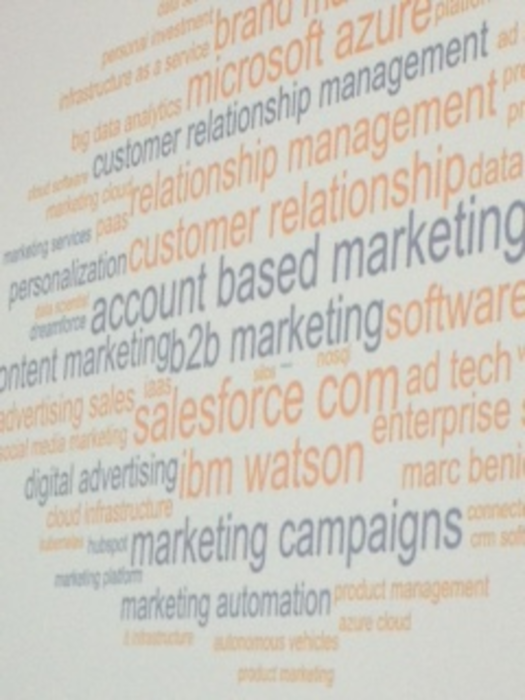Last year’s ABM Innovation Summit was end-to-end about AI. The reason was simple.The only way to deliver personalized, relevant messages to individual members of purchase-teams, at large numbers of accounts, geared to their position in the funnel, was an onslaught of alogrithms – something Demandbase claimed to be in a good position to offer, following the 2016 acquisition of data science specialists Spiderbook.
Spiderbook’s former CEO, Alan Fletcher, is now Chief Product Officer at Demandbase. When I asked him over lunch at the summit why there was less emphasis on AI on this year’s agenda, he acknowledged that customers had taken a step beyond needing to hear about the potential of AI-driven ABM, and now wanted to discuss execution. And execution, what’s more, across new channels.
That’s something that was on Demandbase CEO Chris Golec’s mind too: “The traditional way of B2B marketing, of hoping a company comes to my website; hoping they find the right content; hoping they fill out a long form; and hoping the salesperson calls them back a day later…That’s a lot of hoping.”
But if the alternative is full funnel ABM, driven by AI, isn’t that much more readily accessible at the enterprise level, where there’s large scale data (and large scale ability to invest in tools)? Golec demurred. “With the new platform, we’ve made it much easier for smaller companies to get started, and more economical. They can get started with our platform, and see what’s working and what’s not.”
Executing on full funnel ABM
In a series of sessions, practitioners explained not just how to get started with ABM, but how to execute at a savvier, and more sophisticated level. At the heart of the matter, said Nani Jansen, Demandbase director of product marketing, is audience creation and management. Developing a target account list should go beyond basic parameters (revenue, region, and industry, for example) and look at “fit.” The Demandbase platform, said Jansen, doesn’t just surface lists of ranked target accounts; it provides a detailed explanation of why the accounts are on the list, and why they have the ranking they do.
“‘Fit,'” she said, is about “should you buy from me?” It looks not only at the accounts profile, but at engagement, keyword searches, and other components of “trending intent.”
For Heidi Bullock, CMO of Engagio, and also presenting at Summit, cross-selling and up-selling opportunities add value to an ABM strategy. “For growth and revenue, if you don’t think about your customers, ABM is not going to help you,” she said. Choosing the right accounts to target is a good start: Bullock classified them as “strategic,” “scale”, and “programmatic,” in terms of level of attention. Ongoing value comes from identifying opportunities to add accounts, or to sell more to existing accounts.
Success in cross-selling and up-selling does require an explicit strategy. Goals need to be set, in terms of which products or services are in play. Stages in the funnel – including hand-offs between marketing, sales, and customer success (and SLAs) – need to be defined. She also recommended tying compensation to specific products and services. If a sales team falls back on the easy option of selling the same product again and again, valuable cross-sell and up-sell opportunities will be missed.
Bullock repeatedly emphasized the importance of defining a flexible set of KPIs (she dismissed what she called “random acts of marketing”). At the account level, KPIs might include engagement or campaign success metrics (and engagement signals must be available to sales teams, wherever they’re at work). In terms of journeys, look at the velocity with which accounts can be expected to move from one stage to the next. For the overall program, ROI is important of course, but also multi-touch attribution metrics.
Omnichannel ABM
Last year, the emphasis on AI implied an emphasis on real-time personalization of web content and advertising. The theory was simple enough. Detect intent, show the relevant content, optimize intent scoring, follow-up with ads or by email. This year, Golec wanted to emphasize that ABM is set to grow beyond those basic channels.
“Maybe advertising is not the right answer. Maybe you have the right companies coming in, but you’re not bringing the right content to them. Advertising is the solution to the problem of creating awareness, but there are a lot of solutions beyond advertising, like getting awareness at events: ‘Which events should I go to?’ If the 250 customers I really care about read DMN, I’d better have DMN at the top of my media relations plan. Right now, that process for a lot of PR and comms teams, it’s ‘I think this is the right place…’”
Demonstrating the applicability of ABM to events, Golec showed word clouds reflecting the (actual) online interests of ABM Innovation Summit attendees. Okay, the first word cloud was focused around the term “Stormy,” and featured a number of Kardashians. Reduced to business interests, you can see the results above. It’s a playful indication of the potential for attributing granular intent data to event attendees.
“That’s where it’s headed,” said Golec. “The ability to take this massive intent data and turn it into useful software functionality for marketers.”








